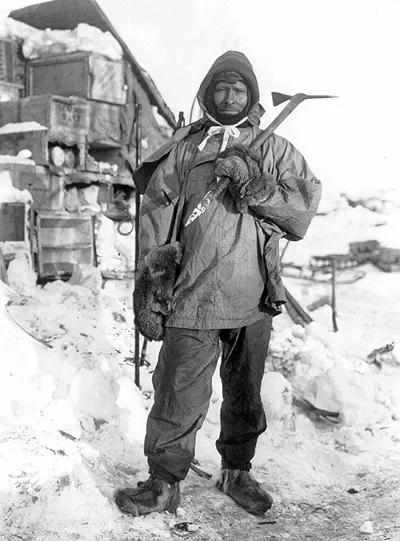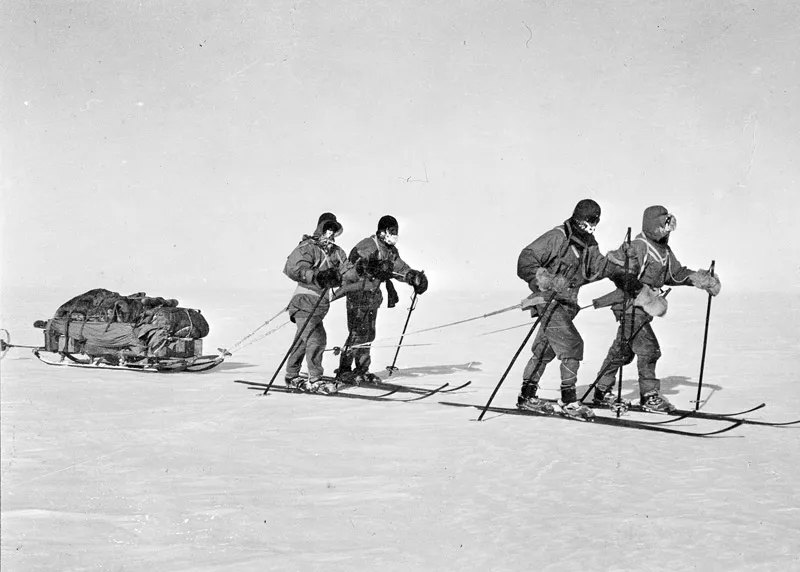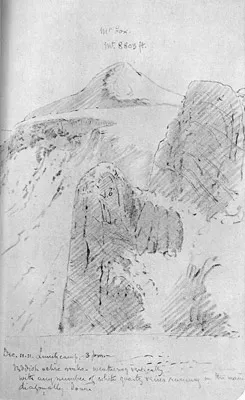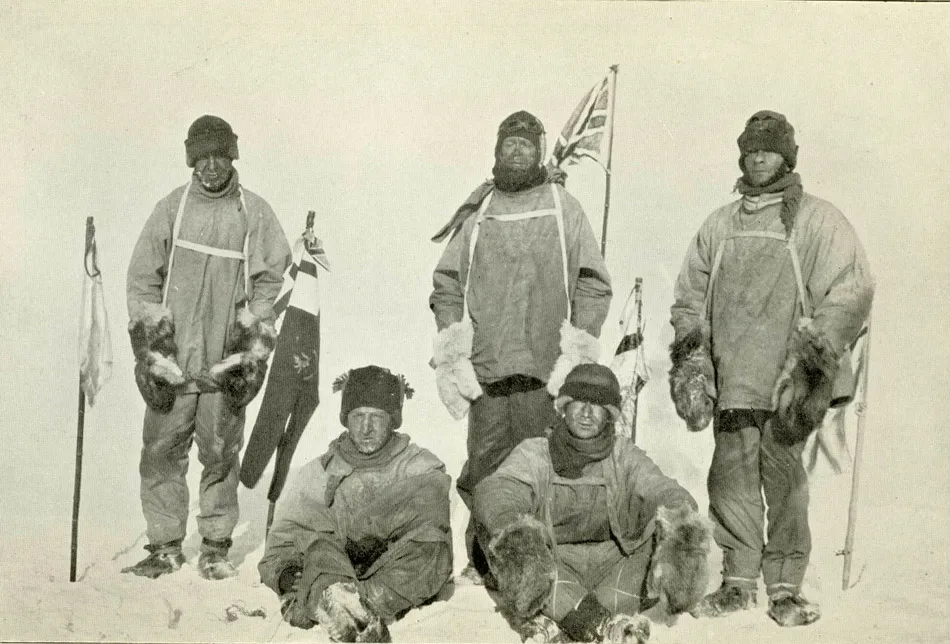Edgar Evans - Petty officer, 2nd class, R.N. (1876 -
1912)
Biographical notes
Petty officer
Discovery
1901-04
Petty officer
Terra Nova
1910-13
Petty Officer Edgar Evans
- Taff
7th March 1876 - 17th February 1912
Born 1876 in Middleton, near Rhossili on the Gower Peninsula in Wales, one of twelve children and the son of a sailor, Edgar Evans enlisted in the Royal Navy at 13 in 1891 and served on the same ship as Scott in 1899. Evans took part in Scott's Discovery Expedition from 1901-1904, he was involved in many sledging operations and proved himself worthy to be asked by Scott to accompany him on the Terra Nova expedition from 1910-1913.
He married Lois Benyon on his return in 1904 and had three children.
He almost didn't make the Terra Nova expedition, falling into the sea while drunk on boarding the ship in New Zealand, another commander might have sent him home, but Scott overlooked this and valued him highly for his strength and cheerful personality. He was responsible for the sledges, tents and all the equipment that was taken by sledging parties, Evans made sure that it was all present and in good working order, a task at which he excelled.
He was part of a four man team who mapped the western mountains of Victoria Land and made geological observations during an 11 week summer and autumn journey from January to April 1911.
He set off for the Pole with Scott on the 1st of November initially leading a pony called Snatcher. He was one of the five men chosen for the South Pole Party with Scott, regarded as the "strongman" and by many of his comrades as an obvious choice for the final group while others on the expedition were uncertain who would make it into the final selection. It was to be his undoing as all five of the polar party, while they reached the south pole, died on the way back.
Evans had a plan for when he returned to Wales after the expedition, he was to open a pub with the hope that his fame as having been one of the first men to reach the South Pole would act to attract customers from far and wide. While he never got to fulfill this ambition, his good friend Tom Crean did the same thing opening the "South Pole Inn" in Annascaul, county Kerry, Ireland, still open to this day.
Evans was the first of Captain Scott's Polar Party to die, on the 17th of February 1912 at the foot of the Beardmore Glacier on the return journey from the Pole.
How did Edgar "Taff" Evans die?
On the way to the pole, Evans cut his hand while making adjustments to one of the sledges with Tom Crean on the 13th of December 1911, this was before the final pole party (intended to be of four) had been chosen . He was quite desperate to be one of the final group and was long thought by the other men to be an obvious choice, he concealed his injury from Scott however and was duly chosen to be one of five to make the attempt on the pole.
Evans demise began with his hand injury, it is thought that it failed to heal properly and became infected. This would have placed additional physiological demands on his body as his immune system increased his body temperature to combat the infection.
All dated quotations on this page are from Scott's diary.
There is no doubt Evans is a good
deal run down - his fingers are badly blistered and his
nose is rather seriously congested with frequent frost bites.
He is very much annoyed with himself, which is not a good
sign.
January 23rd 1912
He was the largest man of the party and equal food rations were given to all of the men each day. We now know that the amount of rations taken by Scott were inadequate to what they should have been for the extremely energy intensive activity of manhauling their sledges. As the largest man and one who anecdotally did more than his share of sledge pulling, these reduced rations would have caused Evans to lose weight more quickly than the other men.
We are pretty thin, especially Evans...
January 28th 1912
Losing body fat and probably carrying an infection in his cut hand from 6 weeks earlier were making things increasingly difficult.
I don't like the easy way in
which Oates and Evans get frostbitten.
January 24th
1912
To add to the trouble Evans has
dislodged two finger-nails to-night; his hands are really
bad, and to my surprise he shows signs of losing heart over
it. He hasn't been cheerful since the accident.
January 30th 1912
Evans' fingers now very bad,
two nails coming off, blisters burst.
February 1st
1912
Evans' fingers are going on
as well as can be expected, but it will be long before he
will be able to help properly with the work.
February
3rd 1912
Evans role was eminently practical, he was the strong-man of the polar party and there seems to have been some loss of self-confidence as a result of his weakened state compounded with a decreasing ability to use his injured hand and no doubt a significant amount of pain.
Just before lunch unexpectedly fell
into crevasses, Evans and I together - a second fall for
Evans, and I camped.... the party is not improving in condition,
especially Evans, who is becoming rather dull and incapable.
February 4th 1912
During one of his falls, Evans most likely hit his head probably sustaining a serious injury which hastened the decline he was already in.
Evans is the chief anxiety now;
his cuts and wounds suppurate, his nose looks very bad,
and altogether he shows considerable signs of being played
out.
February 6th 1912
Evans has no power to assist with
camping work.
February 13th 1912
Evans has nearly broken down in
brain, we think. He is absolutely changed from his normal
self-reliant self. This morning and this afternoon he stopped
the march on some trivial excuse.
February 16th 1912
Evans went on until the 16th of February. He tried to play his role in pulling the sledge and doing his share of the work, but wasn't able.
A very terrible day. Evans looked a little better after a good sleep, and declared, as he always did, that he was quite well. He started in his place on the traces, but half an hour later worked his ski shoes adrift, and had to leave the sledge. The surface was awful, the soft recently fallen snow clogging the ski and runners at every step, the sledge groaning, the sky overcast, and the land hazy.
We stopped after about one hour, and Evans came up again, but very slowly. Half an hour later he dropped out again on the same plea. He asked Bowers to lend him a piece of string. I cautioned him to come on as quickly as he could, and he answered cheerfully as I thought. We had to push on, and the remainder of us were forced to pull very hard, sweating heavily. Abreast the Monument Rock we stopped, and seeing Evans a long way astern, I camped for lunch. There was no alarm at first, and we prepared tea and our own meal, consuming the latter. After lunch, and Evans still not appearing, we looked out, to see him still afar off.
By this time we were alarmed, and all four started back on ski. I was first to reach the poor man and shocked at his appearance; he was on his knees with clothing disarranged, hands uncovered and frostbitten, and a wild look in his eyes. Asked what was the matter, he replied with a slow speech that he didn't know, but thought he must have fainted. We got him on his feet, but after two or three steps he sank down again. He showed every sign of complete collapse. Wilson, Bowers, and I went back for the sledge, whilst Oates remained with him.
When we returned he was practically
unconscious, and when we got him into the tent quite comatose.
He died quietly at 12.30 A.M. On discussing the symptoms
we think he began to get weaker just before we reached the
Pole, and that his downward path was accelerated first by
the shock of his frostbitten fingers, and later by falls
during rough travelling on the glacier, further by his loss
of all confidence in himself. Wilson thinks it certain he
must have injured his brain by a fall.
February
17th 1912
The description of Evans as "on his knees with clothing disarranged, hands uncovered and frostbitten" is strongly indicative of entering the final stages of hypothermia when perception of the cold decreases and even injuries such as frostbite go essentially unnoticed, loosening or even discarding clothing is also characteristic of this stage.
The necessary treatment in these circumstances was beyond the facilities of what the men had. Slow warming in a sheltered environment is needed. All that was available was to erect a tent and put Evans in it, too little and too late to make a difference, even if he could have been revived he had a number of wounds and probable infection, was living on a starvation diet continually losing weight and had a serious head injury, possibly a brain haemorrhage.
His death was something of a merciful release for himself and gave the rest of the polar party a better chance as Evans had been slowing them down for some time, it also freed up rations to be shared between the remaining four men.
After the news of the expedition and loss of all five of the polar party had reached the outside world, Evans reputation suffered from prejudices and incomplete medical knowledge at the time. It was suggested that his lack of education and not being a "Gentleman" were the reasons that he suffered so much on the return journey from the pole being unable to withstand the stresses of manhauling in an environment with minimal mental stimulation.
Some even blamed him for the deaths of the others as he slowed their progress, where later on they might have made it to safety. He was even omitted from cigarette cards that showed all the other members of the Polar Party which was insult to injury for his widow and three children.
In time, Evans' reputation was restored and the earlier insulting and inaccurate assessments of his character dismissed, by 1948 in the film "Scott of the Antarctic", he was portrayed as an important part of the expedition.
Following the news of the expedition reaching the outside world, a "public subscription" was started to collect money to pay off the expedition debts and provide money in particular for the wives and children of the men who had died. Evans widow with her three children to support was given about 1/30th of the amount that went to Scott''s widow with her one child and Scott's sister and mother. The distribution was based on rank and seniority.
Edgar Evans widow Lois had a plaque placed to his memory in St.Mary's church, Rhossilli on the Gower Peninsula
There is a bust of Evans in the Swansea Museum, presented to the people of Swansea by the Lord Mayor of nearby Cardiff in 1994 on the 82nd anniversary of Evans death.
Other references to Edgar Evans in Scott's Diary:
- P.O. Evans and Crean have been preparing sledges; Evans shows himself wonderfully capable, and I haven't a doubt as to the working of the sledges he has fitted up.
- The party gives Evans [P.O.] a very high character.
- We had an excellent game of football again to-day--the exercise is delightful and we get very warm. Atkinson is by far the best player, but Hooper, P.O. Evans, and Crean are also quite good.
- P.O. Evans and Lashly are delightfully intelligent in carrying out instructions.
- Went for a short run on foot this forenoon and a longer one on ski this afternoon. The surface is bad after the recent snowfall. A new pair of sealskin overshoes for ski made by Evans seem to be a complete success. He has modified the shape of the toe to fit the ski irons better. I am very pleased with this arrangement.
References to Edgar Evans by Cherry-Garrard in "The Worst Journey in the World"
- The hardest journey of this year was carried out by Scott with two seamen of whom much will be written in this history. Their names are Edgar Evans and Lashly. The object of the journey was to explore westwards into the interior of the plateau. By way of the Ferrar Glacier they reached the ice-cap after considerable troubles, not the least of which was the loss of the data necessary for navigation contained in an excellent publication called Hints to Travellers, which was blown away. Then for the first time it was seen what additional difficulties are created by the climate and position of this lofty plateau, which we now know extends over the Pole and probably reaches over the greater part of the Antarctic continent.
Landmarks named after Edgar Evans
Feature Name:
Evans Glacier
Type: glacier
Latitude:
83°47'S
Longitude: 170°00'E
Description: A tributary glacier just S
of Owen Hills, flowing E from the Queen Alexandra Range into
Beardmore Glacier. Named by the NZGSAE (1961-62) for Petty Officer
Edgar Evans, who died near here.
Feature Name: Evans Neve
Type: glacier
Latitude:
72°45'S
Longitude: 164°30'E
Description: A large neve which nourishes
the Tucker, Mariner, Aviator, Rennick and Lillie Glaciers. Named
for Edgar Evans of the BrAE, 1910-13, by the Northern Party
of NZGSAE, 1963-64.
Feature Name:
Evans Piedmont Glacier
Type: glacier
Latitude: 76°44'S
Longitude:
162°40'E
Description:
A broad ice sheet occupying the low-lying coastal platform between
Tripp Island and Cape Archer in Victoria Land. Circumnavigated
in 1957 by the N.Z. Northern Survey Party of the CTAE, 1956-58.
Other Crew of the Terra Nova Expedition
Abbot,
George Percy - Petty Officer, R.N. - 1, 2, N
Atkinson, Edward
L. - R.N. - surgeon, parasitologist - 1, 2, D, P, S
Balson,
Albert - Leading seaman, R.N.- 1, 2
Bowers,
Henry Robertson - Lieutenant - 1, 2, D, C,
Po
Browning,
Frank Vernon - Petty Officer - 1, 2, N
Campbell,
Victor - Lieutenant, R.N. - 1, 2, N
Cheetham,
Alfred B. - Boatswain (Bosun), R.N.R.
Cherry-Garrard,
Apsley - Assistant zoologist - 1, 2, D, C, S
Crean,
Tom - petty officer, R.N. - 1, 2, D, P, S
Debenham, Frank
- Geologist - 1, 2, iW, iiW
Dickason,
Harry - Able Seaman - 1, 2, N
Evans, Edgar - petty
officer, R.N. - 1, iW, Po
Evans, Edward R.G.R. - Lieutenant, R.N. "Teddy Evans" -
second in command, and Captain of the Terra Nova - 1, D, P
Girev
(Geroff), Dmitriy - Dog driver - 1, 2, D, P, S
Gran,
Tryggve - ski expert - 1, 2, D, iiW, S
Lashly, William
- chief stoker, R.N. - 1, 2, P, S
Levick,
G. Murray - Surgeon, R.N. - 1, 2, N
Lillie, Dennis Gascoigne - Biologist
on the ship
McLeod, Thomas
F. - Able seaman - 1, 2
Meares, Cecil
H. - in charge of dogs - 1, D, P
Oates, Lawrence
- Capt. 6th Iniskilling Dragoons - 1, D,
Po
Ponting,
Herbert G. - Camera artist - 1
Priestley,
Raymond E. - Geologist - 1, 2, N
Omelchenko,
Anton - Groom - 1
Scott, Robert
Falcon - Commander, R.N. -
Expedition leader - 1, D, Po
Simpson,
George - Meteorologist - 1
Taylor,
T. Griffith - Geologist - 1, iW, iiW
Wilson,
Edward Adrian - chief of scientific staff and biologist - 1, D, C,
Po
Wright,
Charles Seymour - Physicist - 1, 2, iW, P, S
Key:
1 - first winter
2 - second winter
iW - first western party
iiW - second western party
N - northern
party
D - depot laying for south pole journey
P - south pole party
C - winter journey to Cape Crozier
S - search party for south Pole
party
Po - reached
South Pole
Biographical information
- I am concentrating on the Polar experiences of the men involved.
Any further information or pictures visitors may have will be gratefully received.
Please email
- Paul Ward, webmaster.
What are the chances that my ancestor was an unsung part of the Heroic Age
of Antarctic Exploration?






